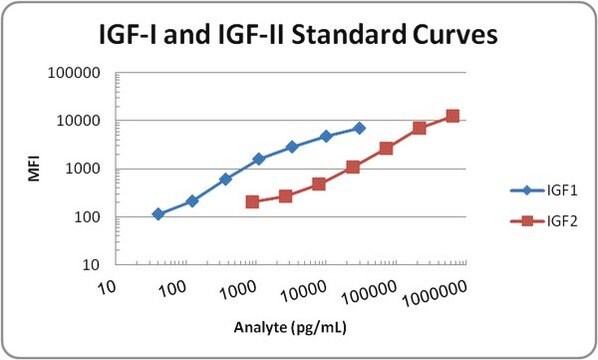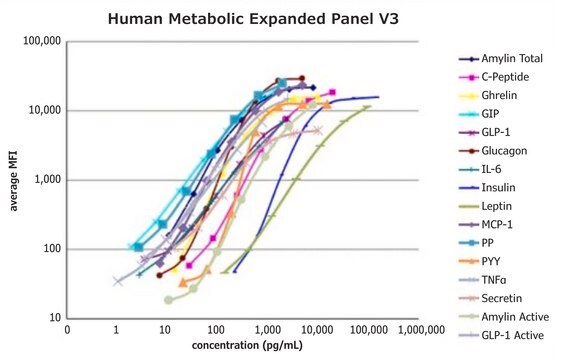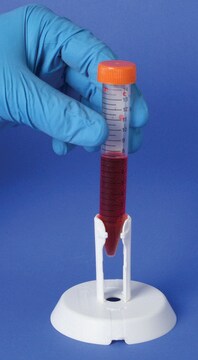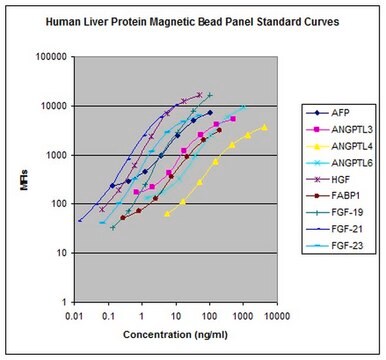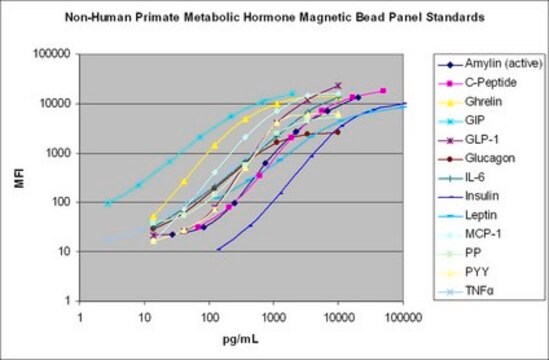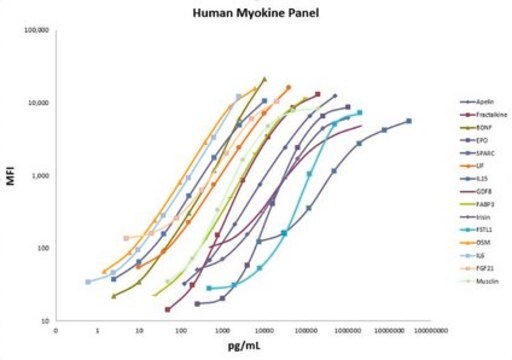HIGFBMAG-53K
MILLIPLEX® Human IGF Binding Protein Magnetic Bead Panel - Metabolism Multiplex Assay
The Human IGF Binding Protein Panel, using the Luminex xMAP technology, enables the simultaneous analysis of 7 IGFBP protein biomarkers in human serum, plasma and cell culture samples.
About This Item
Produits recommandés
Niveau de qualité
Espèces réactives
human
Fabricant/nom de marque
Milliplex®
assay range
accuracy: 79%
(IGFBP-5)
sensitivity: 0.01 ng/mL
(MinDC+2SD; IGFBP-1)
sensitivity: 0.07 ng/mL
(MinDC+2SD; IGFBP-7)
sensitivity: 0.12 ng/mL
(MinDC+2SD; IGFBP-6)
sensitivity: 0.15 ng/mL
(MinDC+2SD; IGFBP-3)
sensitivity: 0.96 ng/mL
(MinDC+2SD; IGFBP-4)
sensitivity: 1.09 ng/mL
(MinDC+2SD; IGFBP-2)
sensitivity: 9.87 ng/mL
(MinDC+2SD; IGFBP-5)
standard curve range: 0.03-25 ng/mL
(IGFBP-1)
standard curve range: 0.07-50 ng/mL
( IGFBP-3)
standard curve range: 0.07-50 ng/mL
(IGFBP-7)
standard curve range: 0.14-100 ng/mL
(IGFBP-6)
standard curve range: 0.34-250 ng/mL
(IGFBP-2)
standard curve range: 0.69-500 ng/mL
(IGFBP-4)
standard curve range: 1.37-1000 ng/mL
(IGFBP-5)
inter-assay cv: <15%
intra-assay cv: <10%
(IGFBP-1)
inter-assay cv: <15%
intra-assay cv: <10%
(IGFBP-2)
inter-assay cv: <15%
intra-assay cv: <10%
(IGFBP-3)
inter-assay cv: <15%
intra-assay cv: <10%
(IGFBP-4)
inter-assay cv: <15%
intra-assay cv: <10%
(IGFBP-5)
inter-assay cv: <15%
intra-assay cv: <10%
(IGFBP-6)
inter-assay cv: <15%
intra-assay cv: <10%
(IGFBP-7)
Technique(s)
multiplexing: suitable
Méthode de détection
fluorometric (Luminex xMAP)
Conditions d'expédition
wet ice
Description générale
The MILLIPLEX® Human IGF Binding Protein (IGFBP) Panel, is used for the simultaneous quantification of any or all of the following analytes in human serum, plasma, and cell culture conditioned-media samples: IGFBP-1, IGFBP-2, IGFBP-3, IGFBP-4, IGFBP-5, IGFBP-6, and IGFBP-7. This kit uses a 96-well format, contains a lyophilized standard cocktail, two internal assay quality controls and can measure up to 38 samples in duplicate.
The Luminex® xMAP® platform uses a magnetic bead immunoassay format for ideal speed and sensitivity to quantitate multiple analytes simultaneously, dramatically improving productivity while conserving valuable sample volume.
Panel Type: Endocrine
Spécificité
There was no or negligible cross-reactivity between the antibodies for an analyte and any of the other analytes in this panel.
Application
- Analytes: IGFBP-1, IGFBP-2, IGFBP-3, IGFBP-4, IGFBP-5, IGFBP-6, IGFBP-7
- Recommended Sample Type: Human serum, plasma, and cell culture conditioned-media
- Recommended Sample Dilution: For serum and plasma samples, 25 μL per well of a 1:25 dilution should be used when IGFBP3 is not included in the assay. Use a 1:200 dilution when IGFBP3 is included in the assay. Tissue culture supernatants may be run undiluted or appropriately diluted with control medium.
- Assay Run Time: Overnight (16-20 hours) at 2-8°C. For improved sensitivity for some analytes use a 2 hour incubation at room temperature (20-25°C).
- Research Category: Metabolism
- Research Subcategory: Metabolic Disorders
Caractéristiques et avantages
Conditionnement
Stockage et stabilité
Autres remarques
Informations légales
Clause de non-responsabilité
Mention d'avertissement
Danger
Mentions de danger
Classification des risques
Acute Tox. 3 Dermal - Acute Tox. 4 Inhalation - Acute Tox. 4 Oral - Aquatic Chronic 2 - Eye Irrit. 2 - Skin Sens. 1
Code de la classe de stockage
6.1C - Combustible acute toxic Cat.3 / toxic compounds or compounds which causing chronic effects
Certificats d'analyse (COA)
Recherchez un Certificats d'analyse (COA) en saisissant le numéro de lot du produit. Les numéros de lot figurent sur l'étiquette du produit après les mots "Lot" ou "Batch".
Déjà en possession de ce produit ?
Retrouvez la documentation relative aux produits que vous avez récemment achetés dans la Bibliothèque de documents.
Contenu apparenté
Multiplex immunoassays, such as MILLIPLEX® multiplex metabolic assays, are critical in metabolic syndrome research because they provide a full picture of the different conditions related to it, like diabetes and obesity, as well as save time and sample volume.
Notre équipe de scientifiques dispose d'une expérience dans tous les secteurs de la recherche, notamment en sciences de la vie, science des matériaux, synthèse chimique, chromatographie, analyse et dans de nombreux autres domaines..
Contacter notre Service technique